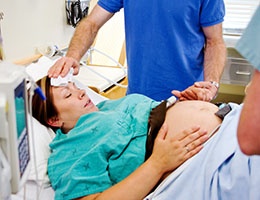 Imagine this scenario: You have been following this 22-year-old primigravida patient since she transferred into your practice at 18 weeks gestation. She tells you that she started her pregnancy weighing 195 pounds; it is now two weeks before her due date and she weighs 248 pounds.
Imagine this scenario: You have been following this 22-year-old primigravida patient since she transferred into your practice at 18 weeks gestation. She tells you that she started her pregnancy weighing 195 pounds; it is now two weeks before her due date and she weighs 248 pounds.
She failed her 28-week glucose screen; after the 3-hour oral glucose tolerance test, she was diagnosed as being a gestational diabetic. Despite referrals to a dietitian and to the Diabetes Clinic, her blood sugar control and dietary compliance have not been good. At her prenatal visit last week, her fundal height was measured at 43 cm.
Shoulder Dystocia Risk Factors
Although many risk factors have been claimed for shoulder dystocia, the only independent, primary risk factors that have been confirmed are:
- Previous shoulder dystocia
- Fetal macrosomia
- Maternal diabetes
- Instrumental delivery
Most other risk factors actually derive from the above.
1. Previous Shoulder Dystocia
The rate of recurrence of shoulder dystocia in a subsequent pregnancy in a woman who has had a previous shoulder dystocia is roughly 10%. This makes sense, as the size of the maternal pelvis does not change from pregnancy to pregnancy. This is a sufficiently high percentage that it is “standard of care” to review this risk with patients who have had a previous shoulder dystocia and offer them the option of a cesarean section.
Medical-Legal Point
It is hard to defend a physician when a brachial plexus injury occurs in a woman who has had a previous shoulder dystocia and who is allowed to deliver vaginally without having been thoroughly counseled as to her risks. If a vaginal delivery is allowed with such a history, it must be clearly documented in the medical record that the patient understands the risk of recurrence of shoulder dystocia as well as the possible consequences that can result.
Sometimes physicians are blindsided by not being aware of a previous shoulder dystocia. This may be because the physician did not have the patient's previous medical records or because the patient did not offer that information when her medical history was obtained at her first prenatal visit. It may also be that the patient was unaware that she had a shoulder dystocia with a previous delivery.
When taking a patient history, rather than simply asking if the patient ever had a shoulder dystocia, a more productive question would be, "Was there any difficulty with any of your deliveries?" A positive answer to this question should result in further investigation as to what really happened with those births.
2. Fetal Macrosomia
Obviously the bigger the baby, the more difficult it will be for it to fit through the maternal pelvis.
That having been said, there is much controversy as to what constitutes macrosomia. The definition most frequently offered in the current obstetrical literature is >4,000 g. Several major obstetrical texts, however, still define macrosomia as >4,500 g — roughly 10 lbs. This latter weight is 2 standard deviations from the mean fetal weight of American babies.
Much of this dispute is irrelevant. Fetal weight is something that can only be estimated prior to delivery, and present-day tools for making such an estimate are imprecise. Ultrasound weight estimates at term are only accurate to within 10% to 15%.
Moreover, studies have shown no difference in accuracy between ultrasound estimates of fetal weight, estimates by experienced clinicians, and estimates by pregnant women themselves.
Medical-Legal Point
There is much confusion in court between obstetricians and lawyers regarding 1) the generally accepted definition of macrosomia; and 2) ACOG recommendations as to how suspected macrosomia should be handled.
As mentioned, the most generally accepted definition of macrosomia varies between >4,000 or >4,500 g. This definition makes no distinction between babies of diabetic and non-diabetic mothers. This is often confused with the following statement in the ACOG Bulletin on Shoulder Dystocia:
Planned cesarean delivery to prevent shoulder dystocia may be considered for suspected macrosomia with estimated fetal weights exceeding 5,000 g in women without diabetes and 4,500 g in women with diabetes.
It is of note that the statement says that cesarean section in these circumstances "may be considered."
3. Maternal Diabetes (Gestational or Pre-Gestational)
In addition to babies of diabetic mothers on average being larger than babies of non-diabetic mothers, their subcutaneous fat is distributed differently. Babies of diabetic mothers tend to store fat in their upper bodies; therefore, they have larger abdomen-to-head and chest-to-head ratios.
This increases the chance that the shoulder diameter of such babies will be too wide to fit through the maternal pelvis. This tendency towards macrosomia and the differential distribution of subcutaneous fat occurs in babies of diabetic mothers even when maternal glucose control during pregnancy has been good.
There is also growing medical-legal concern about "partial glucose intolerance"; this is where elevated sugars are short of the requirement for a diagnosis of gestational diabetes. It occurs when the one-hour glucose tolerance test is elevated, but the three-hour confirmatory test shows either no abnormal values or only one abnormal value instead of the two needed for the diagnosis of gestational diabetes.
More and more frequently, plaintiff’s lawyers are arguing that even partial glucose intolerance places a fetus at risk for macrosomia and disproportionate fat distribution leading to shoulder dystocia. Several articles in the literature over the last several years have seemingly confirmed an elevation in the risk of shoulder dystocia for babies of women in this category, lending some credence to the concept of partial glucose intolerance.
Medical-Legal Point
Plaintiff's lawyers will often claim that their injured infant client became macrosomic and therefore experienced a shoulder dystocia at birth because a practitioner did not properly manage the mother's diabetes.
While one's threshold for offering a cesarean section is decreased by the knowledge that the baby's mother has diabetes, decisions as to mode of delivery ultimately rest on the estimated size of the fetus.
Therefore, how well or how poorly diabetes has been controlled in pregnancy is only significant to the extent that it affects the estimated fetal weight. In a poorly controlled diabetic, one would not automatically do a cesarean section if the estimated fetal weight were relatively low.
Of course, meticulous management, liberal consultation and stringent documentation of the care provided to pregnant women with diabetes is essential both for providing "best practice" medicine and for liability protection.
It is almost always a good idea to order an ultrasound in late pregnancy in gestational diabetic patients to estimate fetal weight. If the estimate of fetal weight approaches either the ACOG guidelines or a physician's personal threshold for concern, consider offering the patient the option of an elective cesarean section for delivery, and document that offer.
4. Instrumental Delivery
The fact that vacuum or forceps are needed to deliver a baby's head implies that maternal fatigue, fetal distress, or a relative fetal-maternal disproportion is present. It is the responsibility of the obstetrician to be mindful of the possibility of relative fetal-maternal disproportion when deciding on an instrumental delivery due to the risk of shoulder dystocia.
Published data shows a three-fold increase in the incidence of shoulder dystocia when instrumental delivery is employed. Therefore, in situations where there is suspected macrosomia or where gestational diabetes is present, one should evaluate all delivery options carefully before performing an instrumental vaginal delivery. If the decision is made to do a forceps or vacuum delivery in such circumstances, the rationale for this decision should be thoroughly documented.
Medical-Legal Point
In lawsuits for shoulder dystocia-related brachial plexus injuries, plaintiff’s lawyers will frequently claim that the use of forceps or the vacuum was a major precipitator of the shoulder dystocia. They will quote articles that cite statistics about the increase in risk for shoulder dystocia with instrumental deliveries.
But such data is misleading. Those articles almost always review cases where a low- or mid-forceps/vacuum was used. Therefore, the risk data in these studies does not apply to the sort of pure outlet forceps or vacuum usually employed today, where the baby's head is directly on the perineum and in OA position.
Additional Considerations
 On careful analysis, several other conditions that have been claimed to be risk factors for shoulder dystocia prove to be only secondary factors for the fetal macrosomia with which they are associated.
On careful analysis, several other conditions that have been claimed to be risk factors for shoulder dystocia prove to be only secondary factors for the fetal macrosomia with which they are associated.
Maternal Obesity and Maternal Weight Gain in Pregnancy
Maternal obesity, commonly seen when there is a shoulder dystocia at delivery, is a factor only in so far as it leads to fetal macrosomia. Babies of the same weight have roughly the same risk of shoulder dystocia regardless of the weight of their mothers. The same applies for maternal weight gain during pregnancy.
There is, however, a correlation between fetal size at birth and maternal weight and/or maternal weight gain. Thus, in a perfect world where no mother was obese at the start of her pregnancy and no woman gained more than 25 pounds during her pregnancy, babies would be smaller and shoulder dystocias would be less frequent. In practice, however, control of pre-pregnancy weight is impossible, and control of maternal weight gain during pregnancy difficult.
Maternal Age and Parity
Any correlation with shoulder dystocia and maternal age and parity arises because older women and parous women are usually heavier than younger women and primigravidas. As noted, heavier women tend to have heavier babies, and this is the factor that increases the risk of shoulder dystocia.
Prolonged Second Stage of Labor
Whether or not prolonged second stages of labor are associated with an increase in shoulder dystocia is controversial. Different studies draw different conclusions. To the extent that there is a correlation, common sense tells us that larger babies are more difficult to push out, thus prolonging the second stage; it is therefore likely that it is the increased size of these babies that predisposes to shoulder dystocia and not the length of the second stage per se.
Episiotomy
Although performing an episiotomy is either a recommended or suggested maneuver in most protocols for shoulder dystocia resolution, the data does not support this advice. Studies have shown no difference in the frequency or degree of fetal injury in shoulder dystocia deliveries with or without an episiotomy.
This stands to reason given that shoulder dystocia is caused by bony-tissue obstruction, not soft-tissue obstruction. The only reason to perform an episiotomy when a shoulder dystocia occurs is if the deliverer's hand does not fit into the posterior aspect of the vagina to perform either a rotational maneuver or to attempt the delivery of the baby's posterior arm.
Pitocin
The use of pitocin (oxytocin) in labor has not been found to be an independent risk factor for the occurrence of shoulder dystocia.
Medical-Legal Point
Despite multiple papers in the obstetrical literature confirming that only the primary risk factors previously listed are independently associated with shoulder dystocias, plaintiff’s attorneys will claim many other factors to be "red flags" that should have warned the doctor that a shoulder dystocia was likely. There is no scientific verification for most of these claims.
Moreover, with each supposed risk factor mentioned, the plaintiff’s lawyer will often repeat that each put the mother at "higher risk" without quantifying how much higher.
Another tactic often used is to link multiple real or imagined risk factors together to create a chain of "warning signs" in the jury's mind. The goal is to make the jury believe that the physician should have known that a shoulder dystocia was imminent, and should have advised the patient of these multiple risks and recommended a cesarean section for delivery.
This is all nonsense, of course. In the first place, often what are claimed to be independent risk factors are not. Secondly, many factors can "increase risk" to some unspecified degree without being significant enough to warrant prophylactic action.
Most importantly, the only risk that matters is that of a permanent brachial plexus injury, not just the occurrence of shoulder dystocia. Although disconcerting, neither a shoulder dystocia nor a temporary brachial plexus injury is a severely morbid event.
Rouse, in a famous paper in JAMA 1996, showed that 3,695 cesarean deliveries would have to be performed for each permanent brachial plexus injury prevented if there were a policy of performing cesarean sections on all patients whose babies were thought to weigh 4,500 g or above.
For the highest group — diabetic mothers with suspected macrosomic babies — the "number necessary to treat" would still be 443 cesarean sections. Neither level of risk crosses the threshold where it would be reasonable or mandatory for a physician to offer the option of elective cesarean section to his or her patients for this weight indication.
Additionally, remember that these cesarean operations are not without significant morbidity in women with diabetes who are often obese.
Pelvimetry
It is sometimes claimed that:
- Prenatal evaluation of the mother's pelvic dimensions is a requirement to screen for the possibility of "relative" cephalopelvic disproportion leading to shoulder dystocia.
- If evidence of such an evaluation ("clinical pelvimetry") is not present on the chart, it is a violation of the standard of care.
Such claims are totally without foundation. Neither clinical nor X-ray pelvimetry is used in modern obstetrics, other than possibly for testing the suitability of allowing for a breech vaginal delivery. Except for obvious deformities such as rickets or previous pelvic fractures, the test of the adequacy of a mother's pelvis is labor itself.
Interested in learning more for CME?
Shoulder dystocia is covered extensively in this course for CME.
Related Content
- Targeting Obstetrics Malpractice Claims
- Obstetrics: Delays in Treatment of Fetal Distress
- Mapping Clinical Risks to Frequent Obstetrics Claims
- 5 Recommendations to Reduce Obstetric Nursing Stress
- A Distressed Labor and Delivery Unit


